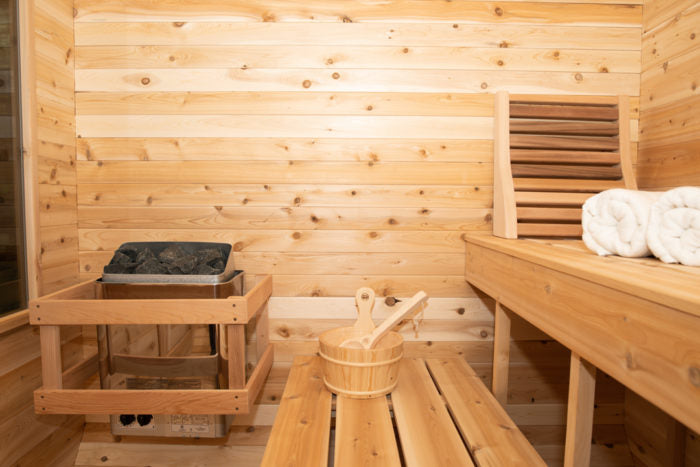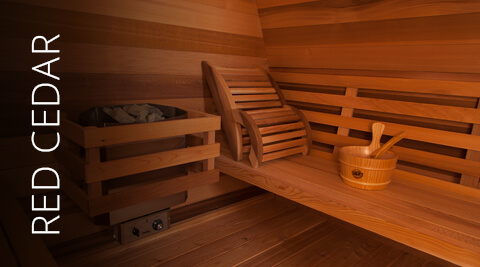Excitement About Traditional Sauna
Excitement About Traditional Sauna
Blog Article
Everything about Traditional Sauna
Table of ContentsThe Best Strategy To Use For Traditional SaunaIndicators on Traditional Sauna You Need To KnowExcitement About Traditional SaunaMore About Traditional SaunaThe Only Guide to Traditional Sauna
The majority of the weight shed in a sauna is water loss and is re-gained upon rehydrating. However, certainly sauna can be a vital part of a healthy weight loss program. To consider the differences between conventional and IR saunas, I will separate these right into proven, theoretical, and produced distinctions.Hence, the most popular point in the saunawhich is at the ceiling directly over the sauna heateris generally between 185 and 190 F. Claims that a conventional sauna goes beyond 200 F is merely not real and not suitable for electric saunas offered in the US. The temperature level for a far-infrared sauna is generally set in between 120 and 140 F; nonetheless, unlike the standard sauna, the goal in and IR room is not to accomplish a high temperature.

When a traditional sauna has actually been properly warmed, the sauna wall surfaces are warm, the air temperature level has achieved set temperature level and the rocks are very warmed. As an interesting side note, the heated wall surfaces and the rocks are giving off far-infrared warm, combined with the warmed air, to produce an "wrapping up heat".
Traditional Sauna Fundamentals Explained
When the high temperature is attained, the components cycle on and off to preserve the high temperature level. Many typical sauna individuals delight in putting water over the rocks to create steam to increase sauna moisture levels. The benefits of pouring water over the rocks include: making the space more comfortable, moistening the nasal flows, and permitting the use of aromatherapy by mixing vital oils with the water.

When the power goes into the body, it creates the body temperature level to boost and eventually leads to sweat. In an infrared sauna it is essential for the emitters/heaters to continue to be on virtually frequently. Given that there is no mass of rocks to retain heat, the sauna will certainly cool down if the emitters shut down.
The Traditional Sauna Diaries
As pointed out above, the sauna bather in an infrared area intends to place himself in front of operating emitters to obtain optimal advantage from the warmth. The home heating time for both areas can be extremely different, relying on just how the areas are made use of. For a website link typical sauna, a bather needs to permit 30-40 mins for the space to accomplish a desired temperature and to properly pre-heat the rocks.

A well constructed sauna will typically achieve a temperature of 150-160 F in concerning 30-40 minutes. For hotter temperature levels, the area might require to heat for a longer duration.
To some, 15 mins was "lost" while the infrared power heated up the wood panels instead than heating a body, while others find a pre-heated space to be more comfortable and think an elevated beginning temperature is needed to start sweating. The size of recommended usage for each area is around the very same (10-15 mins per session); however, due to the lower air temperatures and the capacity to really feel the impacts of infrared warm quicker than a traditional sauna, it is not uncommon for a person to invest an overall of 20-30 minutes in an infrared sauna.
Traditional Sauna Fundamentals Explained

The average cost per kWH of electrical power in the U.S. is approximately $0.11, so a 4.5 kW heating unit will set you back about $.50 to compete one hour, if the heater runs continually for one hour. Generally a sauna heating system will compete 75% of the initial hour and 50% of subsequent hours on considering that the elements cycle once the established temperature level is accomplished.
A two person far-infrared area is normally physically smaller sized than a traditional sauna, typically concerning 4' x 4' or smaller. The IR heating unit is typically 1.5-1.7 kW making use of a 120 volt 15 amp plug-in you could check here service. Given that the area can be utilized sooner than a sauna room, we will think the space is made use of for to of an hour including warmth up time.
Lastly, there is a rarely talked about difference in the social experience in between both rooms. While our society has lost several of the social advantage of the standard sauna experience, it can be very socially rewarding (Traditional Sauna). From household time in the sauna, to heart-felt conversations with loved ones, to sauna partiesthe conventional sauna experience can lead to intimate mingling
The Ultimate Guide To Traditional Sauna
The majority of greater end infrared spaces include colored light therapy, sound systems and full-glass fronts.
Report this page